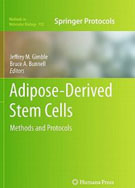Adipose-derived stem cells
Methods and protocols

Adipose-derived stem cells |
 |
Methods in molecular biology, vol 702
Humana Press - Springer pringer Verlag, Heidelberg, Germany
ISBN: 978-1-61737-959-8
Pages: 488; Figures: 82; € 109,95
European Journal of Histochemistry 2011; 55
This book is pleasing the reader already by the Authors’ preface. It is one in a million case to find a figure or a graph in the foreword presentation of a book. Here, Professors Gimble and Bunnell decided to give a warning to the reader about the increasing relevance that the topics covered by the book is playing in the life sciences researches: they simply decided to show the ISI Web of knowledge annual publications and citations for adipose stem cells. Clear enough, the statistics is impressive: few papers in 2000, nearly 600 in 2009 and 2010. The same pattern is present in the citations per year, quite a few in 2000-2001 and something like 12,000 in 2010!
I think that these numbers justify the idea to have a volume devoted to cover all of the topics related to these intriguing stem cell type, likely originating from a perivascular histological niche within highly vascularized fat tissue. The book is divided in four parts (isolation methods, part I; phenotyping methods, part II; differentiation methods: in vitro and in vivo applications, part III; bioengineering, manufacturing and clinical technologies, part IV). Several mammalian adipose-derived stem cells types are presented all along the chapters of part I, from rat and murine till Rhesus and human not forgetting canine, porcine and equine; quite obvious, the human chapter is devoted to the lipoaspirates that so easily are contributed by ladies. The phenotyping methods presented in part II are a central and crucial part of the book for the simple reason that they constitutes the necessary pre-requisite to successfully isolate these versatile cells, which are analogous to other mesenchymal stem cells isolated from different tissues: in fact, like other mesenchymal stem cells, they can differentiate into multiple cell types including osteoblasts, adipocytes, chondrocytes, myocytes and even neuronal cells following ex vivo expansion. Phenotyping by immune responses, cytochines expression, proteomic analyses and flow cytometry are all methods usefull to purify and isolate these stem cells.
The isolation of these cells is the prodrome step to their culture and differentiation: 3-D culture systems seems to be the most promising to get chondrocyte differentiation. Part III illustrates all of the possible cell types that can be differentiated from adipose-derived stem cells: not only chondrocytes but also adipocytes, osteogenic cell types, hepatocytes, smooth muscle cells, endothelial and cardiac cells, epithelial and neural cells. Part IV is a miscellaneous body of chapters devoted to the manufacturing and bioengineering of these versatile cells and noteworthy presenting some clinical applications: periodontal tissue regeneration, skin regeneration and tendon repair.
I am quite sure that the reader, after reading this unique and invaluable book, will easily share my idea that the ASC acronym, stending for Adipose-derived Stem/Stromal Cells and describing the collagenase-digested and culture-expanded adipose cell populations, will for sure appear more and more in the ISI statistics.
CarloAlberto Redi
University of Pavia, Italy
[TOP]